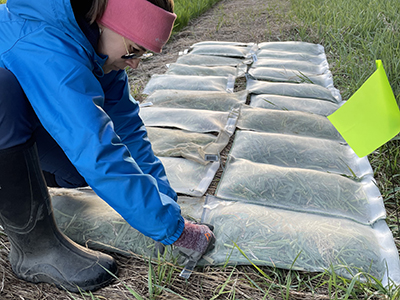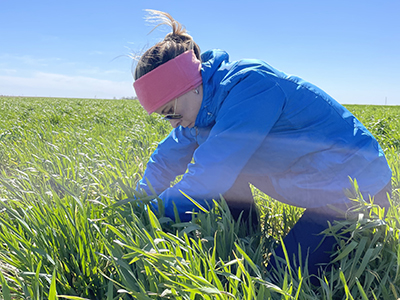Could cover crops replace offset in-season corn fertilizer?

Credit: Tauana Ferreira De Almeida
Over-application of nitrogen fertilizer on crop fields often leads to increased groundwater contamination, as well as a reduction in net financial returns for farmers. With the volatile costs of fertilizer and the large input demand of corn, the optimization of nitrogen use is crucial to both environmental and economic vitality.
DWFI supported student Tauana Almeida and her DWFI Faculty Fellow advisor Andrea Basche are exploring whether nitrogen captured in the soil or biologically fixed by cover crops — plants used to cover the soil in the off-season rather than for the purpose of being harvested — can offset part of the nitrogen fertilizer that should be applied in corn fields during the growing season.
Although prior research exists about nitrogen uptake and release by cover crops, the availability of this nitrogen in-season for cash crops is not well understood and can vary significantly season to season. Almeida and Basche are quantifying the nitrogen released from cover crops decomposition, and subsequently, the amount of nitrogen taken up by corn.
The practice continues to grow around the U.S. and the globe and research could be critical to taking full advantage of cover crops and their potential to supply nitrogen, reducing the amount of nitrogen fertilizer required to be applied. Results will help enhance local and global groundwater health and support DWFI’s mission of minimizing negative agricultural impacts on water quality.

Credit: Tauana Ferreira De Almeida
As cover crops die off and decompose, they release nitrogen and other nutrients into the soil, making it available for future profitable crops. To study how much nitrogen is being released in this process, Almeida and Bache planted cover crop treatments of cereal rye; hairy vetch; and a mixture of cereal rye and hairy vetch; and compared the nitrogen generated to those fields in which no cover crops were planted in order to find a baseline of corn yield measurements.
To capture each cover crops’ nitrogen release, the team sampled biomass (the organic matter above ground) from each one of the cover crop treatments at different points in the growing season.
Researchers dried the samples, measured them and then ground the residue to analyze for the total nitrogen concentration. Almeida and Basche were then able to find the decomposition rate of each cover crop and how much nitrogen was contained in the residue.
They also determined the carbon-to-nitrogen ratio of the cover crops each time the mesh bags were collected, which is important because the carbon-to-nitrogen ratio is one of the drivers of cover crop decomposition. Researchers were able to also determine the nitrogen release rate of the cover crops, which is important for nutrient timing and crop productivity. They were also able to measure how quickly the cover crops grow, and its correlation to the growth of corn.
Almeida and Basche are in the third year of field data collection and evaluation, but current findings suggest that the initial carbon-to-nitrogen ratio of the cover crops plays a significant role in their decomposition and subsequent nitrogen release, which can affect the growth and yield of the corn crop.
They have also found that hairy vetch — a cover crop and pollinator plant — has released up to 75 lbs per acre of nitrogen (or about 84 kilograms per hectare), a significant amount considering an average soybean crop is assumed to release approximately 45 pounds per acre (or about 50.5 kilograms per hectare).
“The incorporation of cover crops can offset a third of a corn field’s nitrogen needs the season," said Almeida.
Almeida and Basche’s work shows promise in using cover crops to reduce the amount of fertilizer farmers need to apply to corn fields and thus, reduce the potential for groundwater contamination from leaching.
FY 2023 Annual Report
- Overview
- Introduction
-
Research and Policy
-
Global
- Brazilian agricultural state looks to Nebraska and DWFI to sustainably manage water resources
- Irrigation equipment ownership not always best for smallholder farmers
- McCornick and Neale re-elected to World Water Council, DWFI involved in preparations for the World Water Forum
- Understanding the agtech ecosystem in India can spur future investments
-
Regional + National
- DAWN Project testing its decision-support tools with corn and soybean growers
- Water Center director helps City of Lincoln find second water source
- Water, Climate and Health program makes an impact in Nebraska
- DWFI's flux tower network now helps validate carbon credits
- Understanding climate’s effect on the health of Americans
- Groundwater transfer success stories guide water managers in meeting local water needs
- Advancements in crop modeling help adapt to climate change
-
Global
-
Education
- Faculty Fellows
-
Supported Students
- DWFI funds eight new students working on mission-related projects
- DWFI continues support of Platte Basin Timelapse interns
- Estimation of manure nutrient capacity in Nebraska minimizes water quality impacts
- Could cover crops replace offset in-season corn fertilizer?
- Congratulations to DWFI-supported student graduates
-
Communication
- Digital and online engagement connects DWFI with its global audience
- Coverage of DWFI research and events reaches more than 219 million people
- Creative storytelling used to amplify DWFI smallholder irrigation research outputs
- DWFI expertise tapped for national reports and publications
- DWFI staff receive well-deserved recognition
- 2022 Nebraska Water Center Annual Report now available
-
Outreach and Events
- Global Conference draws international audience to address water and food security
- On-farm event in Western Nebraska strengthens partnerships, spurs new ideas
- Engagement recovers to pre-pandemic levels
- Drought at forefront of discussions at Platte River Basin Conference
- 49th Annual Water Tour broadens knowledge about Nebraska water
- Nebraska Water Center seminars focus on hot topics in Nebraska Water
- Development
- Resources
- Search
FY 2023 Annual Report
- Overview
- Introduction
-
Research and Policy
-
Global
- Brazilian agricultural state looks to Nebraska and DWFI to sustainably manage water resources
- Irrigation equipment ownership not always best for smallholder farmers
- McCornick and Neale re-elected to World Water Council, DWFI involved in preparations for the World Water Forum
- Understanding the agtech ecosystem in India can spur future investments
-
Regional + National
- DAWN Project testing its decision-support tools with corn and soybean growers
- Water Center director helps City of Lincoln find second water source
- Water, Climate and Health program makes an impact in Nebraska
- DWFI's flux tower network now helps validate carbon credits
- Understanding climate’s effect on the health of Americans
- Groundwater transfer success stories guide water managers in meeting local water needs
- Advancements in crop modeling help adapt to climate change
-
Global
-
Education
- Faculty Fellows
-
Supported Students
- DWFI funds eight new students working on mission-related projects
- DWFI continues support of Platte Basin Timelapse interns
- Estimation of manure nutrient capacity in Nebraska minimizes water quality impacts
- Could cover crops replace offset in-season corn fertilizer?
- Congratulations to DWFI-supported student graduates
-
Communication
- Digital and online engagement connects DWFI with its global audience
- Coverage of DWFI research and events reaches more than 219 million people
- Creative storytelling used to amplify DWFI smallholder irrigation research outputs
- DWFI expertise tapped for national reports and publications
- DWFI staff receive well-deserved recognition
- 2022 Nebraska Water Center Annual Report now available
-
Outreach and Events
- Global Conference draws international audience to address water and food security
- On-farm event in Western Nebraska strengthens partnerships, spurs new ideas
- Engagement recovers to pre-pandemic levels
- Drought at forefront of discussions at Platte River Basin Conference
- 49th Annual Water Tour broadens knowledge about Nebraska water
- Nebraska Water Center seminars focus on hot topics in Nebraska Water
- Development
- Resources
- Search
Top image caption
Vetch and oats are common cover crops used to improve the structure and fertility of the soil.
Credit: Shutterstock | Hawk777
Related Articles
Estimation of manure nutrient capacity in Nebraska minimizes water quality impacts
Using manure fertilizer instead of inorganic fertilizer can better enhance the soil organic matter content while improving soil.
Brazilian agricultural state looks to Nebraska and DWFI to sustainably manage water resources
The Brazilian state of Mato Grosso may not appear to have much in common with Nebraska, a midwestern state of the U.S.
Understanding the agtech ecosystem in India can spur future investments
By 2030, India will have a freshwater shortfall of about 50 percent. Agriculture accounts for 78 percent of the country’s water use and irrigation innovation will be key to meeting the demand for water and food in the future.
COOKIE USAGE:
The University of Nebraska System uses cookies to give you the best online experience. By clicking "I Agree" and/or continuing to use this website without adjusting your browser settings, you accept the use of cookies.

